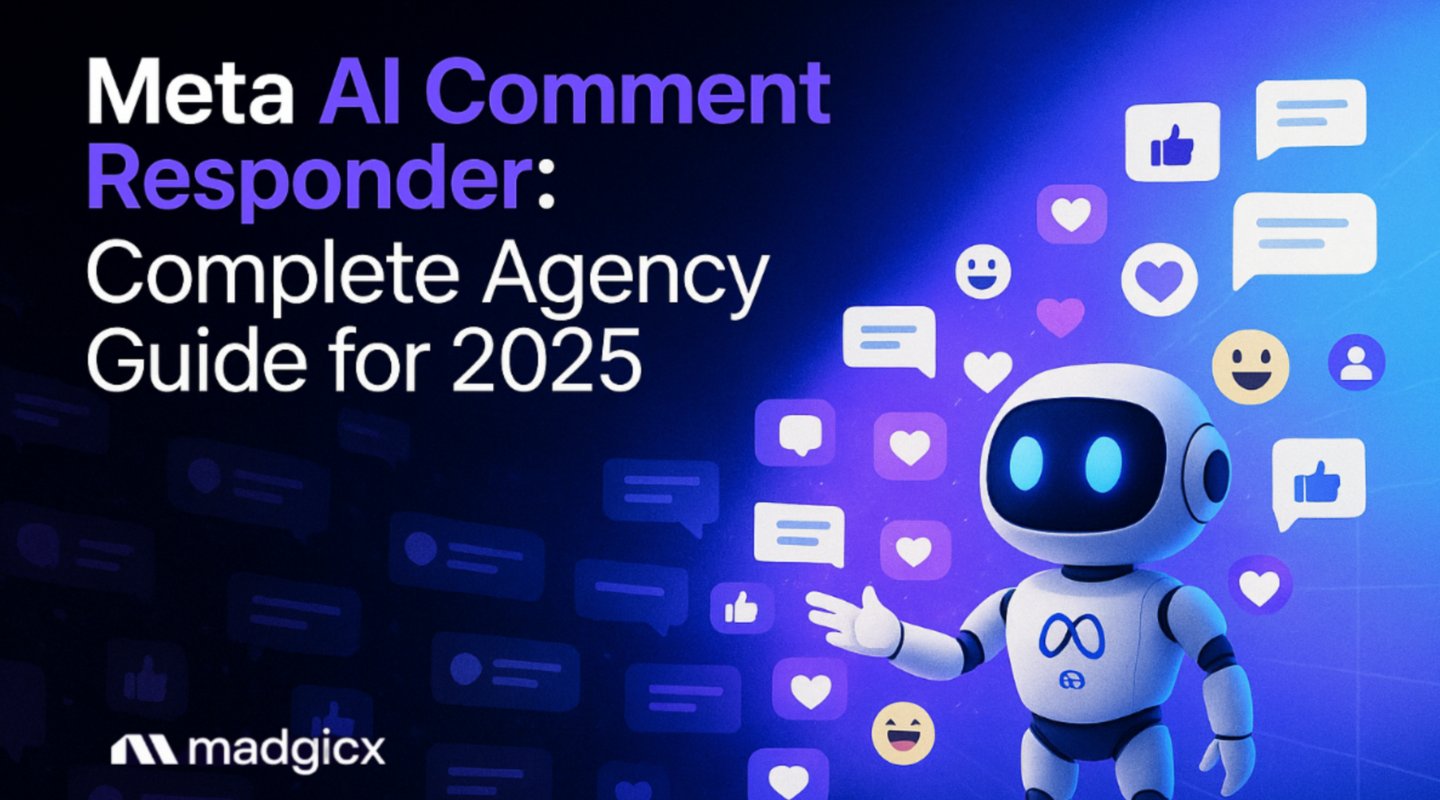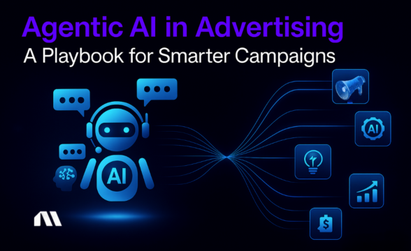Discover how Meta AI comment responder tools automate client engagement while maintaining brand voice. Learn setup, tracking, and scaling for agencies.
Picture this: It's 9 AM, and you're already drowning in client notifications. Sarah's boutique has 47 new Instagram comments, Mike's restaurant has customers asking about delivery on Facebook, and don't even get started on the fitness brand's post that went semi-viral overnight. Sound familiar?
If you're managing multiple client accounts, you know the Meta AI comment responder struggle is real. Your team spends hours crafting responses that could be streamlined, while your clients expect instant engagement that drives actual business results.
Here's what might surprise you: 71% of users cite time-saving as their number one benefit of using AI tools, yet most agencies are still handling Meta platform comments manually.
The good news? Meta AI comment responder technology has evolved far beyond basic chatbots. Today's tools can help maintain authentic brand voices, route complex inquiries appropriately, and even track which responses convert to actual sales. We're talking about systems designed to recognize context, support client-specific tone, and integrate effectively with most existing workflows.
What You'll Learn
- How to set up Meta AI comment responder systems that help maintain each client's unique brand voice
- Multi-client workflow strategies that scale efficiently across your entire roster
- ROI tracking methods that demonstrate Meta AI comment responder value to clients
- Template responses and escalation rules that work across different industries
Why Manual Meta Comment Management Is Limiting Your Agency's Growth
Every minute your team spends on routine Meta comment responses is a minute not spent on strategic work that commands premium rates. Let's do some quick math here: if you're paying junior staff $25-50/hour to respond to comments that could be automated, you're limiting your agency's growth potential while increasing operational costs.
The Hidden Costs Nobody Talks About:
Your team's time isn't the only thing at stake. Delayed responses can hurt client engagement rates, inconsistent brand voice across team members may damage client relationships, and worst of all—there's often limited attribution between social engagement and client ROI. You're working harder, not necessarily smarter.
Most agencies discover they're spending 15-20 hours weekly on Meta comments that could be automated. That's half a team member's time that could be redirected toward AI-powered advertising campaign management or strategic planning that actually moves the needle for clients.
Pro Tip: Track your current time investment for one week. Document every Meta comment response, categorize them by complexity, and calculate the hourly cost. The numbers will likely motivate you to explore Meta AI comment responder options immediately.
The Agency-Specific Meta AI Comment Responder Framework
Here's where most agencies get it wrong: they think Meta AI comment responder tools are just about faster responses. For agencies managing multiple clients, you need sophisticated client separation, brand voice customization, and reporting integration that actually demonstrates value.
Unlike basic chatbots that can sound robotic and generic, modern Meta AI comment responder systems for agencies require a completely different approach. You're not just automating responses—you're scaling personalized client service across Facebook and Instagram.
Essential Features for Multi-Client Management:
Your Meta AI comment responder system needs client account segregation with separate rules for each brand. Sarah's boutique can't sound like Mike's restaurant, and your fitness client definitely shouldn't use the same tone as your B2B software client. Brand voice training for each client's specific style becomes crucial here.
You'll also need escalation workflows for complex inquiries and integrated reporting that ties engagement to business metrics. This isn't just about saving time—it's about demonstrating ROI to clients who are paying premium rates for your services.
Quick Implementation Tip: Start with your highest-volume clients first. Time savings can accumulate significantly when you automate accounts generating 100+ Meta comments weekly. Focus on the 80/20 rule—automate the 80% of routine responses so your team can focus on the 20% that require human creativity.
Setting Up Multi-Client Meta AI Comment Responder Systems (Step-by-Step)
Let's get tactical. Here's exactly how to implement Meta AI comment responder automation that scales across multiple client accounts while maintaining the personal touch that keeps clients happy.
Phase 1: Client Account Architecture
First, create separate Meta AI comment responder profiles for each client. This isn't optional—it's essential. Each client needs their own set of rules, response templates, and escalation triggers. Think of it like having separate filing cabinets for each client, but digital and more efficient.
Define brand voice parameters using existing client content. Feed the system examples of how each client currently responds to Meta comments. If Sarah's boutique uses lots of emojis and casual language, the automation should reflect that. If your law firm client is formal and professional, the responses need to match.
Set up escalation triggers for human review. Not every Meta comment can or should be automated. Create rules that flag comments containing specific keywords, negative sentiment, or complex questions for manual handling.
Configure reporting dashboards for client transparency. Your clients need to see what's happening with their Meta social engagement, and automated systems should make reporting easier, not harder.
Phase 2: Response Template Development
Analyze each client's top 20 Meta comment types. Look at their historical Facebook and Instagram comments and categorize them: product questions, pricing inquiries, compliments, complaints, shipping questions, etc. This analysis becomes the foundation of your Meta AI comment responder templates.
Create template responses that maintain brand voice while addressing common inquiries. The key here is variability—your templates should have multiple versions of the same response to avoid sounding robotic.
Build conditional logic for product-specific inquiries. If someone asks about a specific product on Meta platforms, the automation can be configured to provide relevant information or direct them to the right page on the client's website.
Test Meta AI comment responder automation with small comment volumes first. Don't go live with full automation immediately. Start with a subset of comment types and gradually expand as you refine the system.
Phase 3: Team Integration and Training
Define clear team roles for Meta AI comment responder oversight. Someone needs to monitor performance, update templates, and handle escalated comments. This shouldn't be an afterthought—it's a critical part of your service delivery.
Create escalation procedures for complex situations. Your team needs to know exactly what to do when automation flags a Meta comment for human review. Speed matters here—clients expect quick responses even for complex inquiries.
Establish client communication protocols. How will you inform clients about automated Meta responses? How often will you report on performance? These conversations prevent misunderstandings and build trust.
Set up performance monitoring and optimization schedules. Meta AI comment responder automation requires ongoing optimization based on performance data and client feedback.
ROI Tracking That Demonstrates Meta AI Comment Responder Value to Clients
Here's where most agencies drop the ball: they implement Meta AI comment responder systems but can't prove their value to clients. Companies see $5.44 return for every $1 spent on marketing automation when implemented strategically, but only if you're tracking the right metrics.
Metrics That Actually Matter to Clients:
Response time improvement is your easiest win. Industry average response time is 24 hours, but Meta AI comment responder tools can get that under 5 minutes. That's a measurable improvement that clients immediately understand and appreciate.
Engagement rate improvements from consistent, timely responses show up in Meta analytics within weeks. When comments get quick, relevant responses, more people may engage with future posts. It's a positive cycle that can benefit your client's organic reach.
Lead capture from comment-to-DM automation is where things get interesting. Smart Meta AI comment responder systems can identify potential customers in comments and guide them toward private conversations where sales happen.
Time savings converted to strategic work value is your agency's biggest win. Calculate the hours saved and multiply by your team's hourly rate. Then show clients how those hours are being reinvested in strategy, creative development, or AI marketing campaigns that drive better results.
Attribution Framework That Works:
- Track Meta comment responses that convert to website visits using UTM parameters in automated responses
- Monitor DM conversations initiated from automated responses—these often convert at higher rates than cold outreach
- Measure engagement rate improvements post-automation—many clients report improvements in overall engagement with consistent, timely automated responses
- Calculate team time savings and reinvestment opportunities—this becomes a powerful story for client retention and upselling additional services
Pro Tip: Create monthly ROI reports that show time saved, engagement improvements, and lead generation from Meta AI comment responder automation. Visual dashboards make these metrics more compelling for client presentations.
Advanced Meta AI Comment Responder Strategies for Agency Growth
Once you've mastered basic Meta AI comment responder automation, it's time to think bigger. 77% of marketers use AI-powered marketing automation to create personalized content in 2025, and successful agencies are those that go beyond simple response automation.
Scaling Beyond Basic Automation:
Industry-specific response libraries become your competitive advantage. E-commerce clients need different Meta AI comment responder automation than restaurants, which need different automation than fitness brands. Build template libraries for each vertical you serve.
Seasonal campaign integration with automated responses keeps your Meta AI comment responder automation relevant year-round. Black Friday responses should be different from Valentine's Day responses, and your automation should adapt automatically.
Cross-platform consistency between Facebook and Instagram helps ensure brand voice remains consistent regardless of where customers engage. This is especially important for clients active on multiple Meta platforms.
Integration with client CRM systems for lead nurturing turns Meta social engagement into sales pipeline. When automation captures a lead from comments, it should automatically add them to the client's CRM with appropriate tags and follow-up sequences.
Client Upsell Opportunities:
- Advanced analytics and attribution reporting become premium service offerings
- Custom Meta AI comment responder automation for product launches or campaigns positions your agency as a strategic partner
- Integration with paid advertising for comment-to-conversion tracking connects social engagement with advertising performance
- White-label automation solutions for client's own customers create recurring revenue opportunities
Common Meta AI Comment Responder Pitfalls and How to Avoid Them
Let's talk about where agencies typically struggle with Meta AI comment responder implementation, because learning from others' mistakes is more efficient than making your own.
The Biggest Agency Mistakes:
Using identical Meta AI comment responder automation across different client industries is automation malpractice. Your restaurant client's automation can't sound like your law firm's automation. Period.
Over-automating without human oversight protocols can lead to PR issues. Always maintain human oversight for sensitive topics, complaints, or complex inquiries on Meta platforms.
Failing to update Meta AI comment responder automation as client businesses evolve means your automation becomes stale and irrelevant. Client businesses change, new products launch, policies update—your automation needs to evolve too.
Not tracking ROI metrics that matter to client decision-makers means you can't prove value when contract renewal time comes around.
Success Framework That Works:
- Monthly Meta AI comment responder performance reviews with each client keep everyone aligned and identify optimization opportunities
- Quarterly brand voice audits and template updates ensure your automation stays current with client brand evolution
- Continuous optimization based on engagement data means your automation gets better over time
- Regular team training on new automation capabilities keeps your agency current
Pro Tip: AI forecasting models can predict customer engagement with 83% accuracy, compared to just 57% with traditional methods, but only if you're feeding them good data and optimizing based on results.
Choosing the Right Meta AI Comment Responder Platform for Agencies
Not all Meta AI comment responder platforms are created equal, especially when you're managing multiple client accounts with different needs, brand voices, and reporting requirements.
Essential Agency Requirements:
Multi-account management with client separation isn't negotiable. You need complete separation between client accounts—no cross-contamination of data, responses, or reporting.
Team collaboration features and permission controls ensure the right people have access to the right client accounts. Your junior team members shouldn't have access to your biggest client's Meta AI comment responder settings.
Integrated reporting and analytics dashboards save hours of manual report creation. Your clients want to see results, and manual reporting doesn't scale when you're managing dozens of accounts.
API access for custom integrations future-proofs your Meta AI comment responder setup. As your agency grows and client needs become more sophisticated, you'll need the flexibility to integrate with other tools and platforms.
Connecting Meta Social Engagement with Advertising Performance:
For agencies managing both organic social and paid advertising, the ability to connect Meta social engagement data with advertising performance becomes crucial. Platforms like Madgicx excel at providing unified reporting that shows how social ad engagement contributes to overall campaign performance and client ROI.
This integration helps agencies demonstrate comprehensive value across all client touchpoints, from organic Meta social engagement to paid advertising attribution. When you can show clients how automated comment responses contribute to their overall advertising performance, you're providing strategic value that goes beyond simple time savings.
Frequently Asked Questions
How do we maintain authentic brand voice across automated Meta responses?
Modern Meta AI comment responder systems learn from your existing client content to help maintain consistent brand voice. Start by feeding the system 20-30 examples of each client's preferred response style, then refine based on performance data. The key is variety—create multiple versions of each response template to avoid sounding robotic.
What happens when Meta AI comment responder automation can't handle a complex comment?
Set up escalation triggers that route complex inquiries to human team members. Most platforms allow you to define keywords, sentiment thresholds, or question complexity that automatically flags comments for manual review. The goal is automation for routine responses, human touch for complex situations.
How do we prove ROI to clients who are skeptical about Meta AI comment responder automation?
Focus on measurable metrics: response time improvements (24 hours to under 5 minutes), engagement rate increases (typically 15-30% reported by many clients), and team time savings. Calculate the hourly cost of manual responses versus automation costs, then show how saved time gets reinvested in strategic work.
Can Meta AI comment responder tools handle different languages for international clients?
Yes, advanced platforms support multi-language automation. However, start with your primary language and expand gradually to ensure quality control across all automated responses. Each language needs its own brand voice training and template development.
How often should we update automated Meta responses?
Review and update templates monthly, with more frequent updates during campaign periods or seasonal changes. Set up performance monitoring to identify responses that need optimization based on engagement data. Quarterly brand voice audits ensure your automation evolves with client brand changes.
What's the difference between Meta AI comment responder tools and chatbots?
Meta AI comment responder tools focus specifically on social media comments with brand voice consistency and multi-client management. Chatbots are broader customer service tools. For agencies, comment automation needs client separation, brand voice training, and integrated reporting that chatbots typically don't provide.
Scale Your Agency with Meta AI Comment Responder Technology
Meta AI comment responder automation isn't just about saving time—it's about transforming how your agency delivers value to clients. By implementing the framework outlined above, you'll reduce manual work, improve client satisfaction, and create new revenue opportunities through better attribution and reporting.
Successful agencies in 2025 are those that combine human strategy with AI efficiency. The marketing automation market is projected to reach $15.62 billion by 2030, with a 15.3% annual growth rate, and agencies that adopt these tools early can gain competitive advantages.
Start with your highest-volume client, implement the Meta AI comment responder framework systematically, and watch as your team's capacity for strategic work expands. Time savings can accumulate significantly, but more importantly, you'll be delivering better results for clients while building a more scalable business model.
Ready to optimize your agency's workflow? For agencies managing both social engagement and paid advertising, platforms like Madgicx provide the attribution tracking and performance insights that connect all client touchpoints. The platform specializes in advertising optimization and attribution, giving you comprehensive reporting that clients need to see ROI across all their marketing efforts.
Don't let Meta comment management continue consuming your team's valuable time. Successful agencies are those that automate routine tasks and elevate strategic work. Your clients deserve better than delayed responses and inconsistent brand voice—and your team deserves to focus on work that actually grows client businesses. Try Madgicx for Free!
Reduce time spent on routine Meta comment management with Madgicx’s AI-powered responder tool. Focus on strategic work while streamlined systems help handle routine client responses across Facebook and Instagram.
Yuval is the Head of Content at Madgicx. He is in charge of the Madgicx blog, the company's SEO strategy, and all its textual content.











.jpg)



